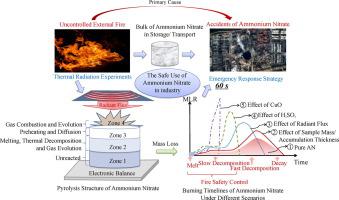Applied Thermal Engineering ( IF 6.1 ) Pub Date : 2020-09-14 , DOI: 10.1016/j.applthermaleng.2020.116044 Qi Sun , Lin Jiang , Huiqi Cao , Jinhua Sun , Ganbin Liu

|
Statistics have indicated that industrial accidents of ammonium nitrate were primarily caused by uncontrolled external fires where heating was dominantly controlled by radiation, and yet existing studies at milligram scale cannot fully simulate the real fire scenarios. To explore the pyrolysis behavior in a typical fire, this study conducted thermal radiation experiments using pure ammonium nitrate and its mixtures with copper oxide and sulfuric acid. Different from the pyrolysis process identified at milligram scale tests, the bench-scale pyrolysis of ammonium nitrate under radiation consisted of four stages. Pyrolysis structure model of each stage was built to reveal the differences in dominated thermal behavior. Results indicated that two additives had different thermo-chemical effects on pyrolysis of ammonium nitrate. Sulfuric acid accelerated the reaction rate of each stage by generating catalytic nitric acid; copper oxide reduced the number of reaction stages into three via surface absorptions. The time and mass loss rate of different stages were determined. Recommendations on effective emergency response were made to prevent the transition of slow decomposition into fast decomposition, and thus to intervene the fire-induced domino effect of ammonium nitrate. This study helps to understand the pyrolysis behavior of ammonium nitrate under fire exposure, and provides insights for pyrolysis modeling and firefighting in industry of interest.
中文翻译:

辐射试验下氧化铜和硫酸对硝酸铵热解行为的影响
统计数据表明,硝酸铵的工业事故主要是由不受控制的外部火灾引起的,外部加热主要由辐射控制,而现有的毫克级研究仍不能完全模拟真实的火灾情况。为了探索典型火灾中的热解行为,本研究使用纯硝酸铵及其与氧化铜和硫酸的混合物进行了热辐射实验。与毫克级测试确定的热解过程不同,辐射条件下硝酸铵的台式热解包括四个阶段。建立了每个阶段的热解结构模型,以揭示主导热行为的差异。结果表明,两种添加剂对硝酸铵的热解有不同的热化学作用。硫酸通过生成催化硝酸加快了每个阶段的反应速度。氧化铜通过表面吸收将反应阶段数减少为三个。确定了不同阶段的时间和质量损失率。提出了关于有效应急响应的建议,以防止缓慢分解过渡为快速分解,从而干预火灾引起的硝酸铵的多米诺骨牌效应。这项研究有助于了解硝酸铵在火势下的热解行为,并为感兴趣的行业中的热解建模和灭火提供了见识。提出了关于有效应急响应的建议,以防止缓慢分解转变为快速分解,从而干预火灾引起的硝酸铵的多米诺骨牌效应。这项研究有助于了解硝酸铵在火下的热解行为,并为感兴趣的行业中的热解建模和灭火提供见解。提出了关于有效应急响应的建议,以防止缓慢分解转变为快速分解,从而干预火灾引起的硝酸铵的多米诺骨牌效应。这项研究有助于了解硝酸铵在火下的热解行为,并为感兴趣的行业中的热解建模和灭火提供见解。











































 京公网安备 11010802027423号
京公网安备 11010802027423号